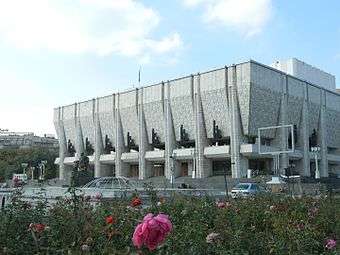Auezov Theater
|
Kazakh: Мұхтар Әуезов атындағы театры Russian: Театр имени Мухтара Ауэзова | |
 | |
| Full name | Kazakh State Academic Drama Theater named after M.O. Auezov |
|---|---|
| Address |
Almaty Kazakhstan |
| Coordinates | 43°14′29″N 76°55′4″E / 43.24139°N 76.91778°ECoordinates: 43°14′29″N 76°55′4″E / 43.24139°N 76.91778°E |
| Owner | Erkin Zhuasbek |
| Capacity | 756 seats |
| Construction | |
| Opened |
1926 in Kyzylorda 1928 in Almaty |
| Renovated | 2008 |
| Reopened | 1963, 1982 |
| Rebuilt | 1981 |
| Website | |
| http://auezov-teatr.kz | |
Auezov Theater with a full name of Kazakh State Academic Drama Theater named after M.O. Auezov is located on Kurmangazy Street in Almaty, Kazakhstan nearby Esentai River. It holds a large 1,000-seat auditorium and a 250-seat experimental theater. The building's exterior and the interior are designed with regular lines on which the surfaces are decorated in traditional style. A series of uniform columns emphasize the main front and make it stand solemn and grand in contrast to the other buildings around it. A Mukhtar Auezov monument which was installed in 1980, located in front of the theater, shows figure resembling Auezov sitting in an armchair as if immersed in his thoughts who was a writer of prose and is most known for The Path of Abai - a book tracing rise of fame and popularity of Abay. The theater is located around with Circus and the Wedding Palace forming a picturesque spot in the city. The theater’s plays are in classical and modern style productions in the Kazakh language in which translation into Russian is provided. Theater works all year round with performances beginning around 6:30pm. A metro station, is also located in front of the theater for which makes it possible to arrive to the location by using a metro.
History
Established in late 1925 in city of Kyzylorda which during it's opening was the capital of Kazakh SSR. The theater opened on January 13, 1926 with a play "Sakina Altyn" ("Golden Ring") Koshka Kemengerova staged a Seraly Kozhamkulova and a big concert. In 1928, after the transfer of the capital to Alma-Ata, the theater was also transferred to the new capital. In 1937, the theater was awarded as a name of Academy Building, and since 1961 with a tribute of death Auezov, the theater was named as Drama Theatre by the name of M.O. Auezov. The roots of the theater who are considered as masters of folk art and amateurs were Arme Kashaubaev, Kurmanbek Dzhandarbekov, Kozhamkulov Serke, Kalibek Kuanyshpaev, Yelyubayev Umurzakov, Isa Baizakov, Kanabek Baiseitov, K. Bader, Munaitpasov K., J. Shanin , F. Ashkeeva, Z. Atabaeva, Shabana Baizakov. During the early years of the theater, directors were nominated from the actor's seat who were Shanin, Kozhamkulov, Dzhandarbekov. On the creation of the first play were worked by writers; In the early years of the theater directors nominated from the actor's environment: Shanin, Kozhamkulov, Dzhandarbekov. On the creation of the first play were worked by writers; Auezov, Seifullin, Myleene. In the early years of staged performances, reflecting the establishment of Soviet power, multiple plays were created which these were "Red Falcons" by Seifullin "Zarlyk" by Uspanov and Uteulin; as well as the performances about life in the old village, pre-revolutionary life of the Kazakh people with the performance name of "Karakoz", "Baybishe - Current" was directed by Auezov, while "Wedding", "Sly Mullah" Maylin "Malkambay" Erdanaeva "Torsykbay", "Aidarbek", "Arkalyk Batyr" were created by Shanin [1]. In the 1930's, the theater attracted professional Russian directors in which were MG Nasonov, IB Hog, MA Sokolovsky, and artist K. Khodzhikov, who were proceeded to setting challenging dramatic works: «Night peals» by Auezov, «Amangeldy» by Mailin and Musrepov. In 1941-45 during World War 2. The basis of the acts of performances devoted to the heroic struggle of the Soviet people: "In the hour of trial" by Auezov, "Guards of honor" by Auezov and Abisheva and "Sir-Ahan - Ak Tokta" Musrepov, "Taming of the Shrew" by Shakespeare. Throughout 1963 until 1982, the theater was located in a new building with 800 seats in the main square named after Komintern, opposite to the park named after A.Imanov, located in Communist now Abylaikhan street. In 1982, the theater was moved to its current and permanent place, it solemnly moved to a new magnificent building in the center of Almaty. The room was fully equipped with the necessary shops and the most modern facilities. There were two rooms, a large hall with 756 seats and a small little room with 276 seats in the theater. The most significant plays from the end of World War II until the 1980s were "Friendship and love", "Career and Conscience" by Abisheva, "Millionaire" by Mustafina, "Yesterday and Today", "Hard Fate" by Khusainov, "One tree - not the forest" by Tazhibaeva, "cub under a cap", "Matchmaker arrived" "In a foreign country," by Mukhamedzhanov, "Saule", "Buran" by Akhtanov, "The Heart of the poet" Shashkin, "unquenchable fire" Kabdolov, "Ascent of Mount Fuji" by Aitmatov, Mukhamedzhanov and many others [2]. In 2006 the theater was closed for renovation. A modern lighting, sound equipment, air conditioning and heating system was installed. The restoration lasted for almost three years, in which theater reopened its doors on December 2008.[1]